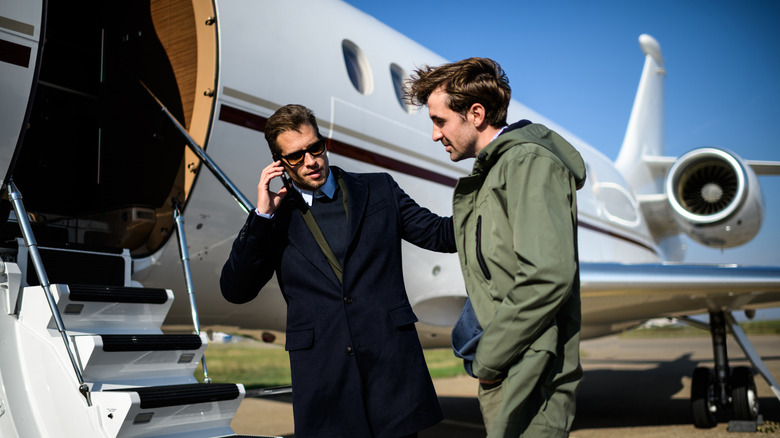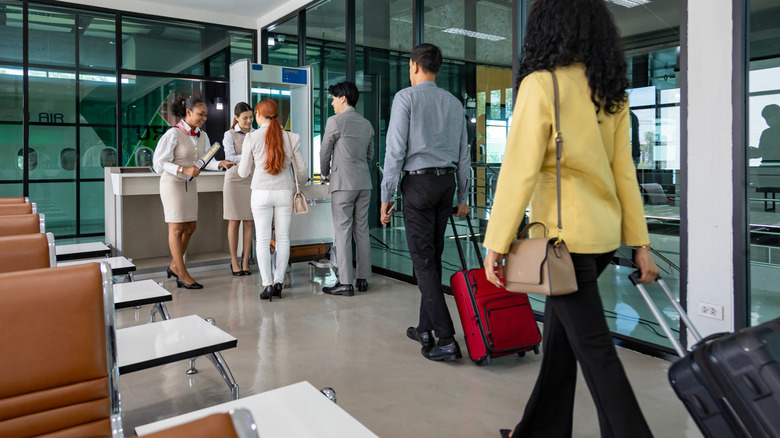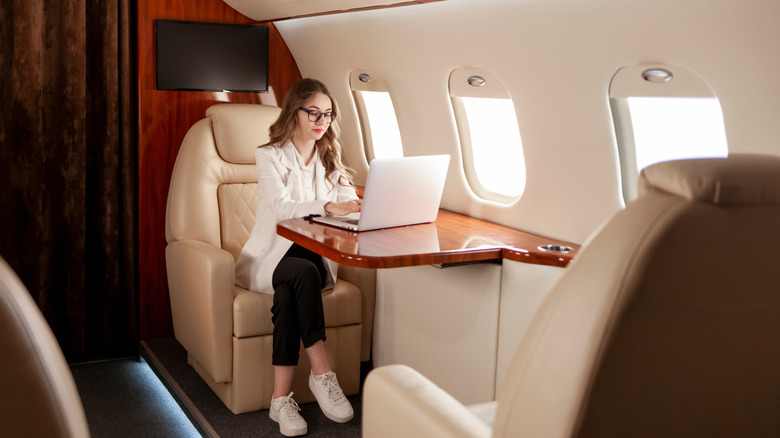Do Private Jet Passengers Have To Go Through TSA Security Checks?
The Transportation Security Administration (TSA) mandates that airline travelers undergo a security screening before boarding their flights to ensure everyone's safety. If you've flown commercial — whether in coach or business class — you're likely familiar with the standard airport checkpoint process. This typically involves walking through a metal detector or body scanner while your carry-on luggage is screened via X-ray. If an alarm is triggered, additional screening is enforced. This process is well-established for commercial airlines, but what about private jet passengers? Do they go through the same TSA security checks?
Like airline pilots and crew members who are screened separately from regular passengers, private jet travelers follow a different security protocol. Their inspection process is generally more streamlined and less intrusive. Most private jet flights operate from fixed-base operators (FBOs), which are airport terminals exclusively catering to private aviation. These private terminals have their own security measures, including identity verification, baggage screening, and random checks. However, since private jet passengers are often high-profile clients, the process is designed to be more efficient and discreet compared to commercial airline security.
Security requirements for private flights vary based on factors such as aircraft size and destination. Smaller private jets carrying only a handful of passengers may undergo minimal screening, while larger private aircraft — especially those carrying more than 61 passengers — must comply with full security protocols. For international private flights, passengers are also required to pass through customs and immigration checks to ensure compliance with cross-border travel regulations.
Differences between private jet and commercial airline security
There are differences between the security screening processes for private jet passengers and commercial airline travelers. Commercial flyers are required to go through standard TSA checkpoints, which include the detailed removal of shoes, belts, and electronic devices, as well as undergoing body scans and pat-downs by officers when necessary. This is to ensure that all screened passengers are safe to board the plane and that prohibited items are confiscated by TSA officials.
On the other hand, under the TSA's Screening Partnership Program (SPP), private aircraft passengers go through the checkpoints operated by private airline companies at the airport. Though separate from commercial flights, these terminals are expected to operate and comply with the TSA's security guidelines. However, private aviation companies are free to employ alternative measures, such as conducting background checks on their clients. Baggage is still screened using X-ray machines or manual inspection, but the process is often quicker and less complicated since only a few passengers are boarding.
Additionally, private flyers enjoy more leeway than commercial passengers when it comes to certain airport regulations. For example, they have more flexibility when carrying liquids and other regulated items. Since private aviation companies operate under different security requirements, they allow their customers to bring larger amounts of liquids and other items that might be restricted on commercial planes. Their passengers are free to carry their favorite beverages and full bottles of body care products without being stopped at the checkpoint.
The state and cost of flying private
More than enjoying a less stressful security screening and boarding process, flying private ensures comfort and luxury. Hence, it is a privilege mostly accessible to the ultra-rich, including entrepreneurs, celebrities, and politicians. The cost of owning a private jet alone requires next-level wealth and financial security. The price of flying logistics is also not for the faint of heart.
Despite its exclusivity, the private jet sector has grown significantly over the years. According to Statista, the total fleet size of the business aviation market increased from 19,894 in 2015 to 21,888 in 2019. During the COVID-19 pandemic, when economies were closed during the lockdowns, the industry only witnessed a low decrease compared to commercial airlines. The global market intelligence firm The Business Research Company (TBRC) also predicts the private jet sector to grow from $21.24 billion in 2024 to $24.28 billion in 2025.
Such financial growth does not necessarily mean that more people are buying private planes, since even the cheapest private jets available today cost at least $2.9 million to own. Instead, there are now more accessible ways to travel on a private flight. One of which is to book a private jet charter that starts at around $7,000 per trip. Since this is a per-flight basis instead of per seat, travelers can form a small group, book a flight together, and then split the bill. Another way is to check for shared jet services and just book a seat on a private flight headed to one's destination.


